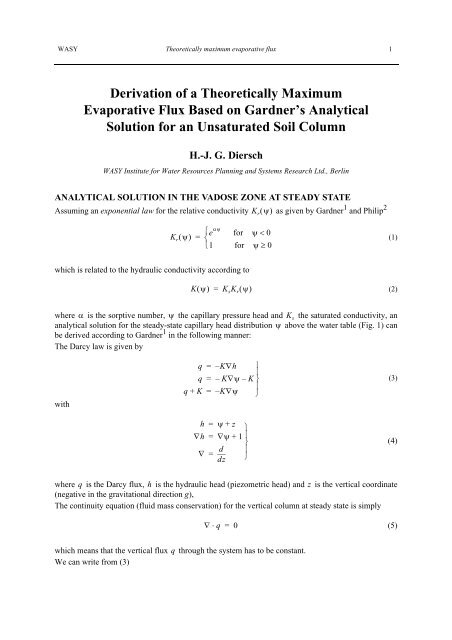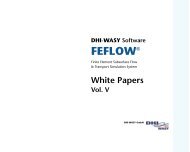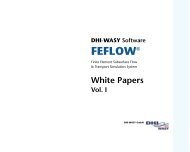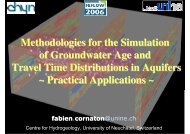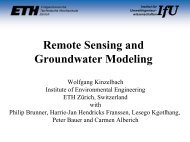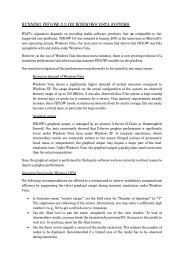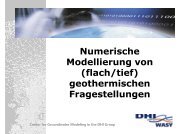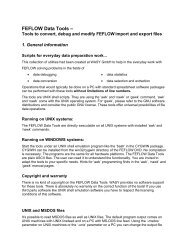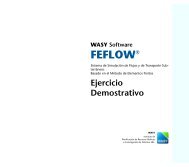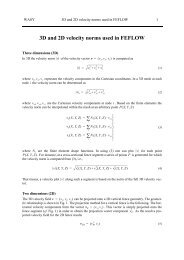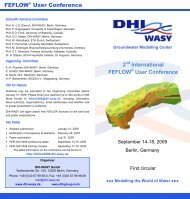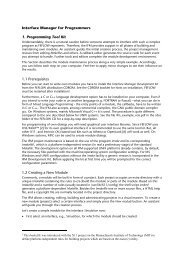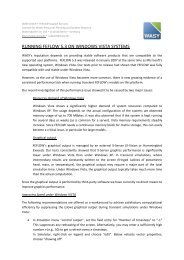Derivation of a Theoretically Maximum Evaporative Flux ... - FEFlow
Derivation of a Theoretically Maximum Evaporative Flux ... - FEFlow
Derivation of a Theoretically Maximum Evaporative Flux ... - FEFlow
You also want an ePaper? Increase the reach of your titles
YUMPU automatically turns print PDFs into web optimized ePapers that Google loves.
WASY <strong>Theoretically</strong> maximum evaporative flux 1<br />
<strong>Derivation</strong> <strong>of</strong> a <strong>Theoretically</strong> <strong>Maximum</strong><br />
<strong>Evaporative</strong> <strong>Flux</strong> Based on Gardner’s Analytical<br />
Solution for an Unsaturated Soil Column<br />
H.-J. G. Diersch<br />
WASY Institute for Water Resources Planning and Systems Research Ltd., Berlin<br />
ANALYTICAL SOLUTION IN THE VADOSE ZONE AT STEADY STATE<br />
Assuming an exponential law for the relative conductivity as given by Gardner 1 and Philip 2<br />
Kr( ψ)<br />
which is related to the hydraulic conductivity according to<br />
where is the sorptive number, the capillary pressure head and the saturated conductivity, an<br />
analytical solution for the steady-state capillary head distribution above the water table (Fig. 1) can<br />
be derived according to Gardner 1 α ψ Ks ψ<br />
in the following manner:<br />
The Darcy law is given by<br />
with<br />
Kr( ψ)<br />
e αψ ⎧ for ψ < 0<br />
⎨<br />
⎩1<br />
for ψ ≥ 0<br />
where q is the Darcy flux, h is the hydraulic head (piezometric head) and z is the vertical coordinate<br />
(negative in the gravitational direction g),<br />
The continuity equation (fluid mass conservation) for the vertical column at steady state is simply<br />
which means that the vertical flux q<br />
through the system has to be constant.<br />
We can write from (3)<br />
=<br />
K( ψ)<br />
= KsK r( ψ)<br />
q = – K∇h<br />
q = – K∇ψ – K<br />
q+ K = – K∇ψ ⎭ ⎪⎬⎪⎫<br />
h = ψ + z<br />
∇h = ∇ψ + 1<br />
∇<br />
d<br />
=<br />
dz<br />
⎭ ⎪⎬⎪⎫<br />
∇ ⋅ q = 0<br />
(1)<br />
(2)<br />
(3)<br />
(4)<br />
(5)
WASY <strong>Theoretically</strong> maximum evaporative flux 2<br />
which can be integrated to obtain<br />
or with (2) and (1)<br />
Substituting<br />
we get with<br />
finally the solution as<br />
dz( q + K)<br />
= – Kdψ<br />
∫dz<br />
∫dz<br />
=<br />
=<br />
vadose zone<br />
water table<br />
–<br />
K<br />
∫------------<br />
dψ<br />
q + K<br />
Kse αψ<br />
q Kse αψ<br />
– ∫----------------------<br />
dψ<br />
+<br />
Figure 1 Sketch <strong>of</strong> the unsaturated solution<br />
domain above the water table.<br />
v<br />
a q Kse αψ<br />
= +<br />
a – q Kse αψ<br />
=<br />
da<br />
-----dψ<br />
αKse αψ<br />
=<br />
da αKse αψ = dψ<br />
dψ<br />
dψ<br />
1<br />
--------- e α<br />
=<br />
αK s<br />
– ψ da<br />
1<br />
--<br />
α<br />
1<br />
= -----------da<br />
a– q<br />
z<br />
L<br />
1<br />
----------- =<br />
a – q<br />
e α – ψ<br />
---------<br />
Ks g<br />
⎫<br />
⎪<br />
⎪<br />
⎪<br />
⎪<br />
⎬<br />
⎪<br />
⎪<br />
⎪<br />
⎪<br />
⎭<br />
(6)<br />
(7)<br />
(8)<br />
(9)<br />
(10)
WASY <strong>Theoretically</strong> maximum evaporative flux 3<br />
where ’ln’ represents the natural logarithm and C is an integration constant to be determined by the<br />
following boundary conditions.<br />
According to Fig. 1, where L is the depth <strong>of</strong> the water table and v is the evaporative flux (exfiltration<br />
rate), we find from the continuity condition (5) that<br />
Furthermore, we know that at z<br />
Accordingly from (11) we obtain<br />
= – L (the location <strong>of</strong> the water table) the pressure head ψ is zero.<br />
Thus, with (12) and (13)<br />
Since<br />
it yields<br />
and<br />
1<br />
∫dz<br />
--<br />
α<br />
1<br />
= – ∫--da<br />
a<br />
z = –<br />
1<br />
-- ln a + C<br />
α<br />
1<br />
z -- ln q Kse α<br />
αψ<br />
⎫<br />
⎪<br />
⎪<br />
⎪<br />
⎬<br />
⎪<br />
⎪<br />
= – + + C ⎪<br />
⎭<br />
– L<br />
C<br />
q = v<br />
= –<br />
1<br />
-- ln q + Ks+ C ⎫<br />
α<br />
⎪<br />
⎬<br />
1<br />
= -- ln q+ Ks– L ⎪<br />
α<br />
⎭<br />
1<br />
z --- ln v Kse α<br />
αψ<br />
= [ – + + ln v+ Ks] – L<br />
1 v + Ks z --- ln<br />
α v Kse αψ<br />
⎫<br />
⎪<br />
⎪<br />
⎬<br />
= ⎛<br />
⎝<br />
----------------------<br />
⎞ – L<br />
⎪<br />
+<br />
⎠<br />
⎪<br />
⎭<br />
v + Ks α( z + L)<br />
ln<br />
v Kse αψ<br />
= ⎛<br />
⎝<br />
----------------------<br />
⎞<br />
+<br />
⎠<br />
e<br />
+<br />
v Kse αψ = ----------------------<br />
+<br />
α z L + ( ) v Ks v Kse αψ<br />
+ ( v + Ks)e α – z L + ( )<br />
=<br />
αψ 1<br />
e ---- ( v+ Ks)e Ks α – z L + ( )<br />
= [ – v]<br />
αψ ln 1<br />
---- ( v + Ks)e Ks α – z L +<br />
⎫<br />
⎪<br />
⎪<br />
⎪<br />
⎬<br />
⎪<br />
⎧ ( ) ⎫<br />
= ⎨ [ – v]<br />
⎪<br />
⎬⎪<br />
⎩ ⎭⎭<br />
(11)<br />
(12)<br />
(13)<br />
(14)<br />
(15)<br />
(16)<br />
(17)
WASY <strong>Theoretically</strong> maximum evaporative flux 4<br />
Finally, we find Gardner’s solution in the form<br />
ψ( z)<br />
1<br />
-- ln e<br />
α<br />
α<br />
– z L + ( ) v<br />
Ks ⎛---- + 1⎞<br />
v<br />
– ----<br />
⎝ ⎠<br />
This solution can be used for either steady evaporation +v or infiltration – v.<br />
TWO INTERESTING CASES RESULTUNG FROM EQ. (18)<br />
Two interesting questions arise 3 :<br />
(1) Which flux is concerned to force the pressure head ψ zero everywhere? From (18) we require<br />
and can easily show that such a situation occurs if the infiltration has the amount <strong>of</strong> the saturated<br />
conductivity<br />
(2) Which flux is concerned to make the pressure head ψ infinity at the soil surface z = 0 ?<br />
This should occur for a certain rate v which represents the theoretically maximum evaporative flux<br />
.<br />
v max<br />
THE THEORETICALLY MAXIMUM EVAPORATIVE FLUX<br />
The pressure head ψ becomes infinity at z<br />
This implies that<br />
= 0 if the argument <strong>of</strong> the logarithm <strong>of</strong> (18) goes to zero.<br />
It gives a solution <strong>of</strong> the theoretically maximum evaporative flux as<br />
where L<br />
is the depth <strong>of</strong> the water table below the soil surface.<br />
=<br />
ln e α – z L + ( ) ⎛ v<br />
---- + 1⎞<br />
v<br />
– ---- = 0<br />
⎝ ⎠<br />
K s<br />
v = – Ks ψ( 0)<br />
= ∞<br />
vmax -------- e<br />
Ks α<br />
=<br />
v max<br />
– L vmax Ks K s<br />
⎛-------- + 1⎞<br />
⎝ ⎠<br />
K s<br />
e αL = ---------------<br />
– 1<br />
K s<br />
v max<br />
(18)<br />
(19)<br />
(20)<br />
(21)<br />
(22)<br />
(23)
WASY <strong>Theoretically</strong> maximum evaporative flux 5<br />
v max<br />
EXAMPLES AND DISCUSSIONS REGARDING<br />
We consider the behavior <strong>of</strong> vmax ⁄ Ks for a typical range <strong>of</strong> α-parameter,<br />
e.g.,<br />
α ( 12510 , , , ) m 1 –<br />
=<br />
Figure 2 illustrates the sharpness <strong>of</strong> the maximum evaporative flux in dependence on soil type α<br />
and depth to the water table L . It points out the very rapid decrease in the evaporative flux as the depth<br />
to the water table increases. Otherwise, the plots <strong>of</strong> Fig. 2 indicate that vmax tends to +∞ for small L<br />
and to zero for large L .<br />
v max /K s<br />
v max /K s<br />
10 0<br />
10 -10<br />
10 -20<br />
10 -30<br />
10 -40<br />
10 -50<br />
1000<br />
900<br />
800<br />
700<br />
600<br />
500<br />
400<br />
300<br />
200<br />
100<br />
0<br />
α = 10 m -1<br />
α = 5 m -1<br />
v max<br />
α = 2 m -1<br />
α = 1 m -1<br />
1 10 100<br />
L [m]<br />
10 -3 10 -2 10 -1 10 0 10 1 10 2<br />
Figure 2 <strong>Maximum</strong> evaporative flux vmax ⁄ Ks in dependence on the depth to the water<br />
table L and the soil parameter α .<br />
αL<br />
(24)
WASY <strong>Theoretically</strong> maximum evaporative flux 6<br />
The maximum evaporative flux seems to be useful to limit the actual evaporation rate in a numerical<br />
simulation, for instance, in such a way as<br />
v max<br />
where can be estimated by<br />
in which, in contrast to the exact formula (23), the depth <strong>of</strong> the water table L is approximated by the<br />
suction head ψ at the surface <strong>of</strong> the soil.<br />
Alternatively, introducing the effective saturation<br />
where s is the saturation and sris the residual saturation, we find for the exponential law the simple<br />
capillary pressure-saturation relationship<br />
It can be used to express directly the maximum evaporative flux as a function <strong>of</strong> the effective<br />
saturation . Since<br />
s e<br />
we find from (26) after simple manipulations<br />
REFERENCES<br />
v actual<br />
=<br />
v max<br />
min v prescribed ( , vmax) s e<br />
K s<br />
e αψ = ------------------<br />
– 1<br />
s e<br />
s – sr = ------------<br />
1 – sr se e αψ = for ψ < 0<br />
s e<br />
– ψ 1<br />
e α<br />
e αψ<br />
= = ---------<br />
v max<br />
seK s<br />
=<br />
------------<br />
1 – se<br />
1. Gardner, W.R., Some steady-state solutions <strong>of</strong> the unsaturated moisture flow equation with application to<br />
evaporation from a water table. Soil Sci. 35 (1958) 4, 228-232.<br />
2. Philip, J.R., Theory <strong>of</strong> infiltration. Adv. Hydroscience 5 (1969), 215-296.<br />
3. Selker, J.S., Keller, C.K. and McCord, J.T., Vadose zone processes. Lewis Publ., Boca Raton, 1999.<br />
v max<br />
(25)<br />
(26)<br />
(27)<br />
(28)<br />
(29)<br />
(30)


